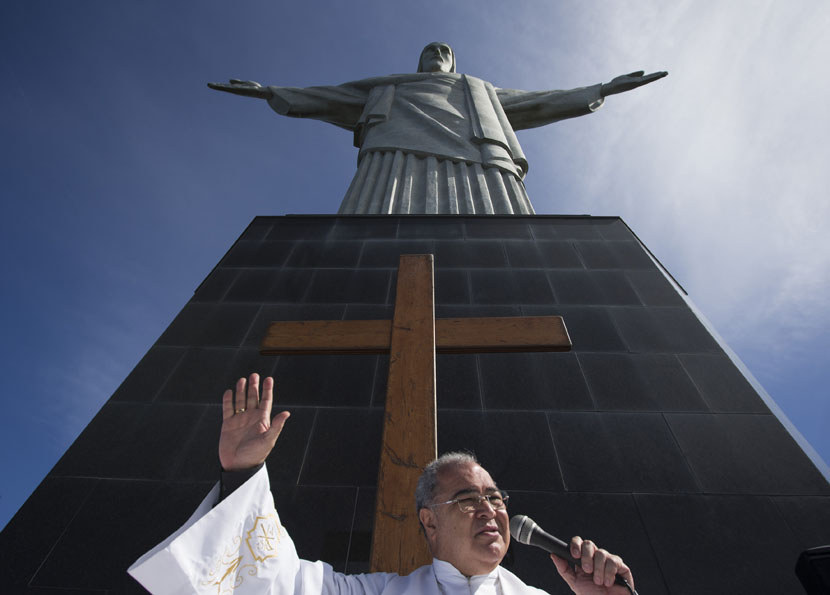Aloysius Stepinac: Serbian soldier, Ustasha villain or a communist victim?! Or all of the above?? (PHOTO)
How is it possible that Aloysius Stepinac is seen as a positive figure in Croatia? Not only by nationalists, which the Balkans is full of, but also ordinary people, even those who do not consider themselves believers? How big of a role did the Communist government have? How did Stepinac from a Thessaloniki Front volunteer become one of the largest villains of the Serbian people? One of the most controversial figures in the region, the future saint and an obstacle to a future meeting of the Serbian Orthodox Church with the Pope, for the Nedeljnik spoke the most famous Serbian, and Croatian historians
This woman knows the secret: This is how my mother reconciled Tesla and Pupin! (PHOTO)
The King, it was said at the time, was one of those who "pushed" the Catholic Church in Croatia, and even the Vatican, which was then ruled by Pope Pius XI, and gave Aloysius Stepinac the title of bishop. The news echoed around the world: at age 36, Stepinac was the youngest bishop on the planet, the King and Serbs praised him.
When he was only twenty, Stepinac fell into Italian captivity - only a few months earlier, Italy finally broke and entered the war on the side of the Entente - after the Battle of Piave, a battle in which Stepinac, an Austro-Hungarian soldier, commanded a Serb, Field Marshall Svetozar Borojevic.
The fifth child of the family of Joseph and Barbara (born Penic) from the village Brezaric, at forty kilometers from Zagreb, the newly developed Lozek in July was requested by the Italians that they free him to go to the Thessaloniki front. Until the spring of 1918, Stepinac fought in Serbian uniform, for the Serbian king for the unification of the South Slavs, and in that uniform, he would see Belgrade for the first time.

But another reason for mutual respect between Stepinac and Aleksandar Karadjordjevic, that early July in Belgrade in 1934, was the realization that the scourge of communism was the biggest problem of mankind. "Only the Catholic Church is able to cope with communism and is capable of catching up with him in the deal," wrote the bishop in his words to the king that day.
"It is my conviction, Excellency," replied the King, "that only the Catholic Church personnel hold the front against communism, and I am very glad that you are open and honest ... ''
The aged and sickly archbishop Anton Bauer had not solely chosen him to be his successor. The Zagreb clergy members did so as well, in an attempt to reconcile Belgrade and the Holy See. Stepinac was ideal: supposedly loyal to the Yugoslav idea, a Thessaloniki volunteer, and with no stain in his career.
DE PUTA MADRE: This is the most incredible man who has ever set foot in Belgrade!
At the end of the July meeting, Stepinac swore allegiance and loyalty to King Aleksandar, and then that country. His vow may have been valid until the end of the life of King Aleksandar, but not until the end of the state. At the very beginning of the war, even before the capitulation of the Kingdom of Yugoslavia on April 12, Stepinac will visit Marshal Slavko Kvaternika, and four days later the Ustasha leader Ante Pavelic, and swear allegiance to him as he did with the King.
It will be the beginning of the controversy that would follow many cardinals after his death, charges that he abetted genocide against Serbs and Jews in the Independent State of Croatia, he never raised his voice against the evil in Jasenovac, in addition to the conflicts between Serbs and Croats and Serbs and the Vatican, which sees no end.

For exactly seventy years since this meeting with King Aleksandar, Aloysius Stepinac was at the gates of paradise. And quite literally - all indications of the Vatican saying that the Blessed Cardinal (that received a halo in 1998, with the blessing of Pope Wojtyla, in Marija Bistrica, in front of half a million believers) will be declared a saint, perhaps even by the end of the year. This caused a stormy reaction from the Serbian Orthodox Church and the president Tomislav Nikolic. SOC addressed the Vatican in their letter whose content has not been published, but it is no secret that the canonization of Stepinac was the biggest problem in the relations between the Serbian Orthodox Church and the Holy See. So much so that the canonization, it seems, will be an insurmountable obstacle to meeting the Pope and the Serbia Patriarch.
The Holy Synod of the Serbian Orthodox Church sent its first letter to the Vatican in 2011, strongly protesting the departure of Pope Benedict XVI at the tomb of Cardinal. Nevertheless, Benedict visited Croatia in June 2011 and prayed at Stepinac's tomb in the Zagreb Cathedral.
"Thanks to the solid Christian conscience, Stepinac knew to resist every form of totalitarianism, and became a defense counsel for Jews, Orthodox and all those persecuted at the time of Nazi and Fascist dictatorship, and then in the communist era an 'attorney' for all the believers, the many persecuted and murdered priests, " Benedict said at the time.
In well-informed circles in the Vatican, it is believed that the process of canonization of Stepinac is unstoppable. And so the Cardinal that Serbs and Jews consider a villain will stand, side by side with Oscar Romero, Archbishop of El Salvador, who literally paid with his life, his commitment to the poor and their loud disapproval because the military regime during the bloody civil war in that country. After years and years of refusal of the Vatican, Pope Francis this week finally said that Romero "was God's man", although the Holy See for years ignored this because of his alleged sympathy to Marxist ideas and communism.

What is the plan of the Vatican? Darko Tanaskovic, a former diplomat and one of the best connoisseurs of the Roman Catholic Church movement and the relationship between the Serbian Orthodox Church and the Holy See says the Roman Catholic Church with Cardinal Stepinac experiences and represents the coordinates of its system of values and criteria, primarily as a martyr victim of one of the two most devastating totalitarianisms of the 20th century, one of the communist rather Stalinist.
"Stepinac's role during the Second World War and his pastoral setting at the time of the monstrous, genocidal politics of NDH towards the Orthodox Serbs were in second place and maintains that not all the details of facts were sufficiently validated and interpreted objectively. This view is, of course, the Serbian nation, the Jews, the Roma, but also for all the anti-fascist oriented and truthful people is unacceptable, as is well known in the Vatican,and the process of canonization of Cardinal real political reasons constantly slowed down, and kept on ice, like the world is incomparably more significant, but in essence analogous proceedings 'ascent to the height of the altar' of Pope Pius XII, "explains Tanasković for Nedeljnik.
Why is Stepinac's canonization actualized just now?
"It is difficult to clearly answer this question. Pressure from certain Croatian, Central European and Latin American bishops and cardinals, as well as certain other Croatia prone, and Orthodox "schismatics' unfavorable officers of the Curia, to accelerate and complete the process of canonization of Stepinac never stopped, just occasionally cyclical ebbed. I remember, for example, that before the last visit of Pope John Paul II (2003) to the Croatian Catholic press, and beyond, an orchestrated environment that was a real opportunity for this God-pleasing act. I think, among other things, an incentive for that right now the cause of Blessed Postulature Cardinal Stepinac out with the sole remaining key evidence of his miracles and present it to Pope Francis may ask for the assessment to clearly strengthen cold winds could be beneficial for the realization of this project which, I repeat, was never placed ad acta. "

Dr Milan Koljanin from the Institute for Contemporary History, one of the best connoisseurs of the Ustasha regime and concentration camps on the territory of NDH, for Nedeljnik explains the root of the conflict with the Roman Catholic hierarchy with the Yugoslav state at a time when King Aleksandar and Stepinac were acquaintances and almost friends.
HAPPY PATRON'S DAY BELGRADE: Here's how the Ascension became a patron of our capital!
"Clerical propaganda emphasized the incompatibility of the liberal principles of the Yugoslav state with the tradition of Croatian people, who is in the 'eternal covenant' with the Holy See. Liberalism, especially freedom of conscience (equality of religion) was rejected as the work of the Masons, who were condemned as great enemies of the Croatian people and the Roman Catholic Church. Meta clerical criticism was also 'international Jewry', which was charged that his attack included the Croatian people. The basic message of clerical propaganda was the view that the Roman Catholic Croats disables life to them by all the foreign state and that they in it, moreover, threatens to ruin. This, implicitly, and more explicitly forced the notion that we must fight against such states to create our own in accordance with the Roman Catholic religious and social principles, the State would again be in its civilizational environment. The most important support of the Ustasha organizations was certainly by clerical circles, in mass Catholic organizations and educational and cultural institutions, among others, the University of Zagreb," says Koljanin and states episode from the life of Aloysius Stepinac.
"The combat clerical orientation of Croatian politics on a symbolic level expressed by the young archbishop of Zagreb, Dr. Aloysius Stepinac during his first public performance at the celebration of the Pope on February 1935. In the great hall of the Zagreb Fair, Archbishop Stepinac spoke to the gathering of several thousand of people with the following words: 'I did not come to earth to bring peace, but war! We are really fighting a war, but a spiritual war, for which we do not need bombs or weapons like the Bolsheviks. This commenting on quotations from the Bible caused strong approval of the audience. "
The relationship between the Vatican and the Roman Catholic hierarchy against the Yugoslav state influence the rejection of the concordat in Belgrade in July 1937 very negatively, against which united the largest part of the Serbian public. Consequently, extreme right party, the Ustasha circles were given the growing support of the Roman Catholic Church. The government tried to do something reagrding the matter, so that the ambassador Mirošević Sogo, on April 30, 1940 protested at the Vatican for Roman Catholic priests connection with Pavelic, Babic, Singer and others. "
All this, then, happens before the war. Dr Koljanin says that no one knows for certain how the high priest of the Roman Catholic Church in Yugoslavia, Stepinac had already been informed of the cooperation of the Ustasha leadership and the Catholic clergy in Croatia, and how much he worked with them. However, he received "Croatian nationalists" with Subasic who advocated for the release of Mile Budak from prison, the editor of the newsletter of the Ustasha Croatian people.
"Stepinac clearly expressed his dissatisfaction with the situation in the country and felt he had to act decisively. He pointed out that the very survival of Croatian Catholic people was threatened, clearly identifying the Serbs and Jews as the main culprits. "The Ustasha state NDH was proclaimed on April 10, just four days after Germany attacked Italy and Yugoslavia, and was the crown of Croatian nationalism efforts to realize their independent country.

"The highest hierarchy of the Roman Catholic Church immediately supported the creation of a new state while aggression of the Axis countries on Yugoslavia was ongoing. The day after the proclamation of the NDH Croatian metropolitan, the Zagreb Archbishop Aloysius Stepinac, visited the interior minister in the interim administration Milovan Zanic. On the same day, Archbishop Stepinac and his retinue visited the government headquarters Slavko Kvaternik. He expressed his "best wishes for his happiness, prosperity and progress of the Croatian people in the State of Croatia. At the same time he expressed his warm condolences over the tragic death of his brother. Petar, brother of Slavko Kvaternik who was otherwise killed while fighting with the Yugoslav army in Crikvenica on the declaration of the Ustasha government, "says Koljanin.
With his letter of April 28, 1941, Stepinac gave full spiritual legitimacy of the ISC and the son of the Croatian people and as a "representative of the Holy Church." The days of her creation called the classes "which does not speak many language more than the blood of his mysterious connection with the country where we saw the light of God with people from which we have sprung. "
"The Roman Catholic church organization, hierarchy, parochial clergy, monastic orders, including the Franciscans in particular, to the fullest extent followed the call of his spiritual shepherd, "says Dr. Milan Koljanin. "And in the Catholic press for the greatest enemies of the Croatian people were declared Serbs, for them and other enemies Europe and called for the ruthless crackdown on them. Croatian army units had their military priests (chaplains), and I was appointed Archbishop Stepinac of the Holy See for the Military Vicar son title for the Croatian army. Archbishop on January 20, 1942 appointed Home Guard chaplains and gave them his parish jurisdiction. For his deputies, he appointed two priests, Stjpena Vucetic and Vilim Cecelja otherwise prominent Ustashas. Chaplains have played an important role in encouraging members of the Croatian armed forces to carry out mass crimes against Serbs. To his credit, as well as many other priests, they are decorated with high Decorations of NDH. Support from the Roman Catholic Ustasha state lasted as long as that state, as evidenced by the Epistle of Croatian bishops of March 24, 1945. "

It remained, however, recorded in his epistle from the Zagreb Cathedral from the 25th of September, 1942, a speech cited by those who defend him, with that that "Jasenovac is a shameful stain on the NDH":
"Each nation and each race, as today are reflected in the country has the right to a dignified life and to a process worthy of man. All of them without exception, were members of the Gypsy race or other, beit black or sleek Europeans, beitd Jews or haughty Aryans has the same right to say: 'Our Father who art in Heaven, 'and if God is all split it right, that human power can you deny? "
How is it possible that Aloysius Stepinac is seen as a positive figure in Croatia? Not only nationalists, which the Balkans is full of, but also ordinary people, even those who do not consider themselves believers? How big of a role did the Communist government, who condemned him for collaborating with the Ustasha, forced religious conversions Serbian population and issued the Yugoslav government? How do moderate Croats ignore the fact that Stepinac on Easter 1941 welcomed the Ustasha state as a "miracle of God"? Is it a sufficient "excuse" that Tito, and the Party made of such a man - a martyr? Or, how would the most competent Croatian historians argue, communist propaganda has made of him, in the eyes of Serbs a villain, that they claim, he never was?
And so, Stepinac (nor) guilty and (nor) at fault shall share the role of those that had been used since the war held, many without evidence. If we draw parallels from watching Croatia, if Pavelic was a Croatian Milan Nedic, and Kvaternik a Croatian Ljotic, then the fate of Stepinac is closest to Draza Mihailovic: a good part of the people never did not accept the results hastily performed by the trial or his guilt, and Stepinac's cult - like Draza's - spread in spite of what is said in the official Yugoslav historiography. When the early nineties came, Stepinac was rehabilitated, in Parliament, mostly thanks to the influential official of the HDZ Vladimir Sheksu, but also the pressure of the hosts. We are trying to answer this question in Zagreb, wrote Dr. Miroslav Akmadža from the Croatian Institute of History, one of the greatest connoisseurs of relations between the Catholic Church with the authorities in Croatia and Yugoslavia, the man who gave a lecture about Stepinac at the exhibition "In the name of the people", held in Belgrade in the summer.
"There are different views of Croatian and Serbian historiography of Stepinac, but in both historiographies are different views on many things, for example, among Croatians about Bleiburg, among the Serbs regarding Draza Mihailovic and the like. Neither the Croatian historians are not unified on the position of Stepinac, although to a larger extent a positive attitude prevails, "says Dr. Akmadža, who does not consider Stepinac "whatever anyone thinks about him," one of the most controversial figures in the region.

"To me, that is Tito, and there are others. But we all need a scapegoat on the other side. For Serbs, that is Stepinac or Tudjman, for Croats Mihailovic or Milosevic, and we feed off of that. "
When asked how Stepinac from a Thessaloniki soldier became hated among the Serbs, Akmadža replies that Stepinac remained true to life, but that opportunities changed.
"Too many look to Stepinac politically. But politics were not his interest. As a priest he held onto "God's god, Caesar's Caesar". As a legalist he accepted every government and communicated with them only as much as he deemed it necessary. But the authorities treated him and the Church differently, however, he did not hesitate to tell them to their face what they deserve. He, like most of the Croats looked forward to 1941 - the establishment of the Croatian state, but was quickly disappointed by the regime and so reacted. He loved the country, but he criticized the regime. In the communist era, he did not want such a state, nor the regime, mostly because he was an atheist. He was not lucky to be a bishop in a democratic regime, even in times of good Croatian-Serbian relations. It is normal that these poor relations maintained the stance of Serbs towards Stepinac, as well as the position of the Croats to the leading people from the Serbian church and political life, "said Akmadža.
You can read the rest of this article in this week's Nedeljnik.
Telegraf.rs zadržava sva prava nad sadržajem. Za preuzimanje sadržaja pogledajte uputstva na stranici Uslovi korišćenja.




